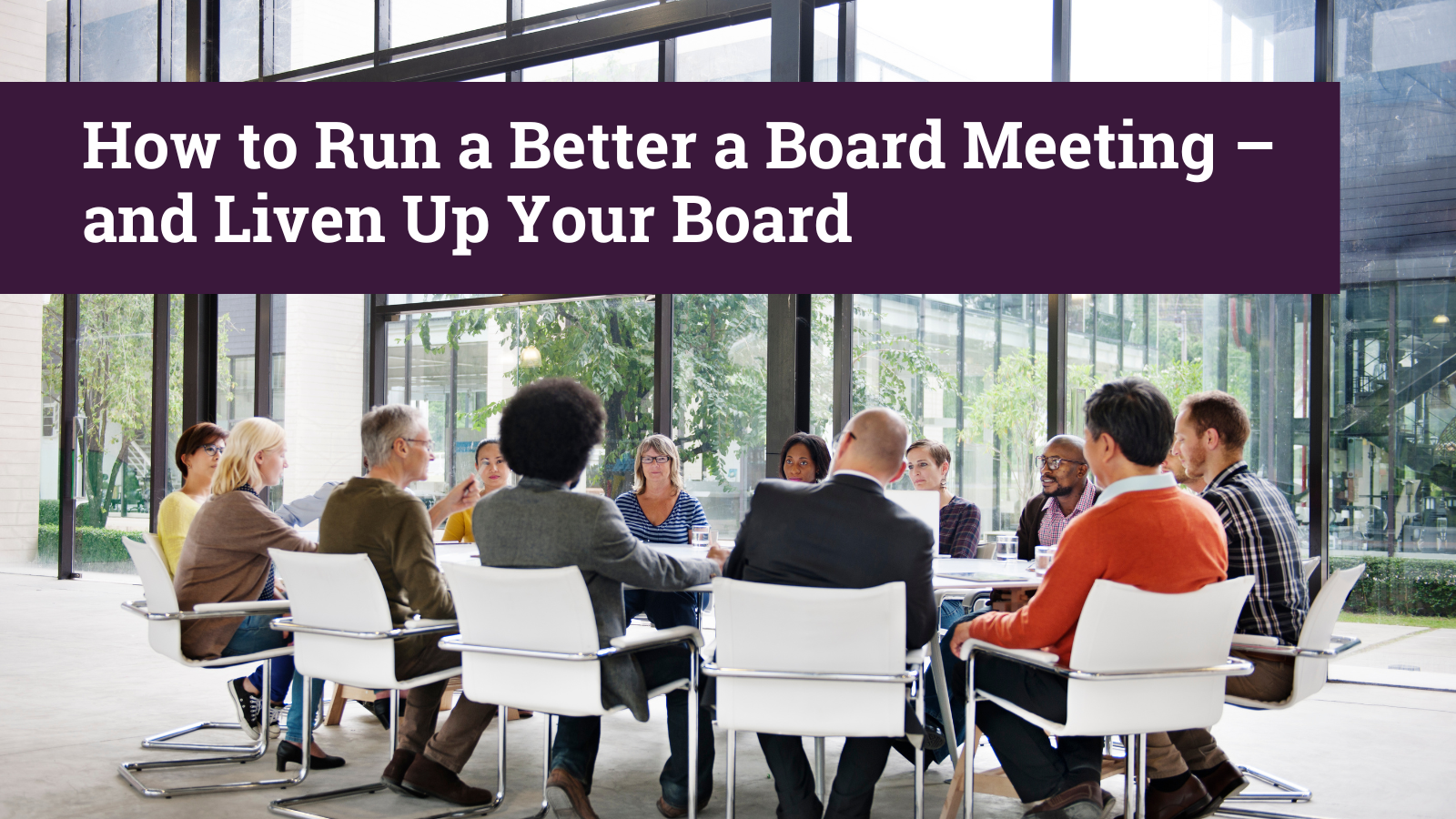How to Run a Better a Board Meeting – and Liven Up Your Board
Board meetings are more important than you and your team may realize. When you think about it, the board meetings are your board members’ principal point of contact with your organization. So, you want the meetings to be great experiences for your board members.
Are the meetings boring? Then you’ll probably have a bored, disengaged board. It’s time to liven things up.
Use these 11 ideas on how to run a board meeting that is truly worth attending – and worth your board members’ valuable time. Take a deeper look: can you create a meeting that will engage your board members’ enthusiasm and deepen their commitment?
1. Be creative with the agenda.
Look for ways to tweak the agenda in ways that will evoke your board members’ interest and engagement.
Avoid a dry recital of figures, and boring committee reports! Instead, can you find a way to humanize your discussions and give the board insight to what your nonprofit is really accomplishing out in the world?
For a more radical approach, consider occasionally throwing out the agenda altogether. The “Participatory Agenda” approach has the board creating its own order of business by consensus at the beginning of the meeting.
When you do that, then everyone is immediately paying more attention to the work that needs to get accomplished in the meeting. In this situation, they are not just meeting for routine reporting and discussing; action needs to be taken on real issues now.
2. Look at your board meetings as cheerleading sessions.
Where is the enthusiasm? How can you use the meeting to fire up your board members and put them into action?
Bring in testimonials. Share stories of your organization’s impact. How can you bring energy and excitement to your board meetings? You could even use meeting time to take your board members on a field trip to see your organization’s work in action!
Consider board members in the role of Ambassadors who have a job to do out in the community. In this case, the role of the staff is to organize, direct, and encourage them.
To pull this off, identify which board members are opinion leaders who can rev up the energy of your board.
3. Focus the agenda on results.
Look for ways to structure real discussions among board members that will elicit commitment and leadership.
Consider what decisions are needed most out of this meeting, and set your agenda accordingly. Tell your board members at the beginning of the meeting session what decisions need to be made.
“By the end of this meeting, we need to accomplish x, y, and z.”
That will get their attention.
4. Focus on problems, challenges, or broad issues.
Discussions of this nature will activate your board members’ various backgrounds and skills sets, not to mention their interest.
It will allow you to draw upon a deeper reservoir of their talent and energy, and will give them more interesting work.
Remember board members are supposed to be focusing on strategic issues – they are not supposed to be “managing” the organization. Keep their focus on the big picture, rather than on operational issues, and remind them of their role/boundaries.
5. Look at trends within routine reports.
Identify larger, big-picture issues that are reflected within routine reports. For example, along with the financial report, consider a discussion of long-run implications of certain revenue or cost trends.
What are three important questions anyone might want to ask about this month’s financial report? Identify these questions yourself and introduce them to the board as discussion topics.
Also, during the regular fundraising report, you could schedule a big-picture discussion of the pros and cons of a subject, such as fundraising events, which we know to be high cost and effort while providing a lower financial return than cultivating major donors.
Remember when board members truly understand the ROI of fundraising, they are more willing to invest in the fund development program.
Or, for a robust fundraising discussion, you might have the board brainstorm how they could help steward donors and increase donor retention.
6. Plan big – add strategy discussions.
Consider bringing big-picture strategic planning topics into regular board meetings.
For example, you could take the standard strategic planning issues focusing on organizational strengths, weaknesses, opportunities and threats (SWOT analysis).
In this case, you could divide the four subjects over four board meetings. At each meeting, take your board through a discussion or update on one of these issues. Again, you are focusing the board on strategy, rather than operations.
7. Interview the Executive Director.
Your Executive Director deals with many challenges that board members never even confront. The Director’s report to the Board rarely includes some of the deeper, more strategic issues that they often deal with. An unscripted conversation with the ED can be far more interesting than a formal report.
Why not consider allowing time for the board members to interview the executive director about what is on their mind?
Our favorite question to ask is: “What keeps our CEO up at night?” Often they are relieved to be asked that question. And their answers are often surprising, and illuminating, to board members.
How about a relaxed “fireside chat” with your ED for about 10 minutes at each meeting? What an interesting discussion this could be, and how engaging for board members.
8. Always choose one interesting item and set it up for a discussion.
If you are nervous about turning your board loose and are not sure where the discussion might go, then let a couple of trusted board members know in advance about the planned discussion.
Tell them your perspective and what you need from the board’s conversation on this issue.
9. Select a theme for each meeting.
Follow the advice of the Alliance for Peacebuilding CEO, Chic Dambach, who likes to select a theme for each meeting based a particular need or issue facing the organization.
He says, “This allows ample time for in-depth analysis of that topic.
For particularly important issues, the theme can be repeated over the course of several meetings until the issue has been adequately addressed.”
10. Break into groups.
Instead of reporting to board members about an upcoming challenge, present the issue as a question and ask them to discuss it in small groups.
Then the board chair can facilitate the full group discussion afterwards.
Having small groups enables everyone to speak, encouraging shy people, those who typically avoid speaking to the full board, to participate.
11. Create “mission moments” in every board meeting.
Many organizations do include mission moments, but too frequently, these are lackluster presentations. If you want to give your trustees a personal experience of your mission in action, then be sure to make it an emotionally powerful story.
Use a testimonial or a story that can touch your board members’ hearts. If you do it right, this could be the most powerful moment of the entire meeting.
BOTTOM LINE: How to Run a Board Meeting
Take charge of the agenda. Set up your meeting to accomplish what you need from your board. Make it interesting and engaging for everyone!
As always, it is a pleasure to share our weekly insights with you as we discuss essential fundraising strategies. If your organization is planning a capital campaign or expanding its major gifts program, we can help. Email coaching@gailperry.com to schedule a free strategy call with us.
Resources:
 2024
2024

 2024
2024